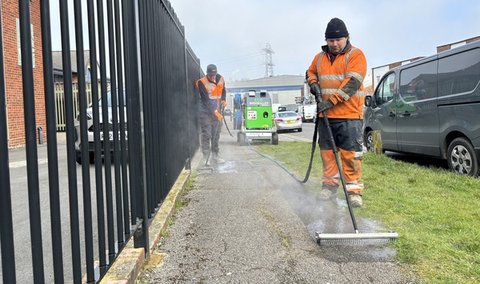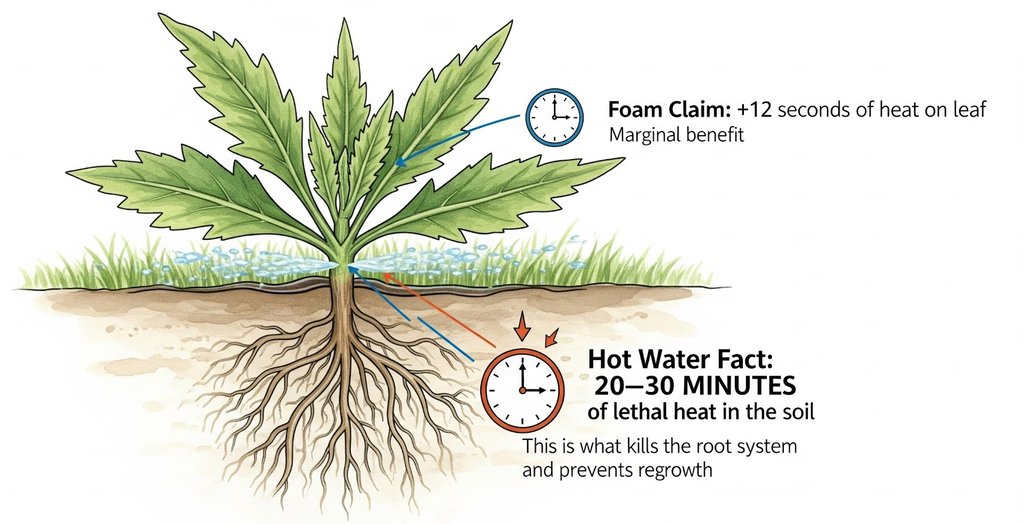Comparing Hot Water to Foam Weed Control
The primary marketing claim of weeding systems using foam is that they typically maintain kill zone temperatures for longer than alternatives like hot water alone. But is this accurate or necessary?
If you've looked into alternatives to glyphosate in the UK, the chances are you've probably considered using hot foam. Many people who have seen hot foam and were unimpressed then initially discount hot water, assuming that if the foam didn't work for them that the hot water won't either.
This post aims to show why that is a bad assumption.
When we compare our hot water system, to the hot water of their marketing, we find that the two don't look anything alike.

Here's why:
They claim that the water leaves the lance at 98 degrees in both their machine and ours.
This is not the case.
Our water is super heated and leaves the lance at 100 degrees or above. We can tell this because of the boiling noise and steam produced when the water comes out of the nozzle. We can adjust the flow of water to ensure this is always the case, no matter what the weather - so you are always delivering boiling water.
For their machine, it is difficult to tell if their water is in fact leaving the lance at 98 degrees, as at that temperature there is no boiling sound. The reality may be that weather is influencing the outcome and reducing the temperature of the water as it travels along the pipe meaning it may leave their lance at a much lower temperature.
They claim that water temperature is reduced to 64 degrees celsius in a 5cm travel distance between the nozzle and the plant without the foam.
This is also not the case (at least in normal conditions).
Firstly, the height of the lance above the ground is determined by the caster wheels it runs on. The distance between the lance and the ground is more like 2cm if there is no plant between, so the maximum distance the water is travelling is 2cm.
Secondly, the cooling above ground depends on the ambient temperature of the air and other factors such as the wind. If you pour boiling water onto a thermometer 5cm from our machine, you will find that at normal room temperature the water only drops in temperature by a few degrees.
They claim that the water only stays above the kill zone (57 degrees) for roughly 2-3 seconds, whereas the foam keeps it above the kill zone temperature for around 15 seconds.
Again, this is very dubious, as we can show with the thermometer.
However, this only considers the situation above the ground. The real damage is in fact done in the soil by damaging the roots. Soil is a far better insulator than foam and in fact keeps the water temperature around the roots above the kill zone temperature for roughly 20-30 minutes after application.
This makes the potential of an additional 12 seconds above the ground pale into insignificance. It is far more important to ensure enough water has been delivered into the soil in order to damage the roots of the plant, than it is to maintain above ground temperature for a few seconds longer.

They claim that hot water needs to be applied once per month throughout the season, whereas foam will reduce this to between 2 - 3 treatments per year.
Again, I can refute this claim.
There is no definite answer with either system. It is very dependent on the types of weeds being treated, the type of soil and the amount of water delivered to the plant.
- In some circumstances I have pictures of an area treated with hot water, which is still mostly weed free after a whole year with just one application.
- In others, where the water has been applied too quickly, it could recover in less than 4 weeks.
Here are some other reasons why our hot water delivery systems are more cost effective and deliver better results than a foam machine in many circumstances.
| Feature / Benefit | Eco Weedkiller | Foam Machine |
| Mobility & Size | Far more compact; easy to move along pavements without needing to stay close to a vehicle; no constant search for parking. | Larger and usually tethered to a large vehicle, requiring frequent repositioning and parking. |
| Running Costs – Foam | No foaming agent required. | Requires foaming agent (~2.4 kg/hour), which can quickly add up to ££££'s per year. |
| Operating Temperature | Consistently 100 °C+ (audible boiling sound confirms). | May not consistently maintain boiling-point temperatures. |
| Water Volume Output | Higher potential output (varies by model), increasing productivity. | Lower water volume output. |
| Range | Hose reels up to 80 m for better reach. | Shorter hose range. (20-30 m) |
| Pressure Washer Power | Up to 150 bar (higher powered diesel engine). | Around 85 bar. |
| Fuel Requirements | Single fuel type: diesel or HVO (simpler, quieter, more reliable). | Requires both petrol and diesel (more expensive, noisier, less reliable). |
| Ergonomics | Lightweight trigger (~1.6 kg); water bypasses hand grip for comfort. | Heavier trigger (~2.5 kg); water passes through hand grip, increasing discomfort. |

Hot water is a safe, reliable, efficient way to manage weeds. You just need to ensure that you purchase the right machine for the job.
We have a wide range of machines, including fully electric machines, which provide cost benefits and are almost silent in operation, making them perfect for use around schools, hospitals or retail parks.
For more information check out our hot water machines here
No comments yet. Login to start a new discussion Start a new discussion